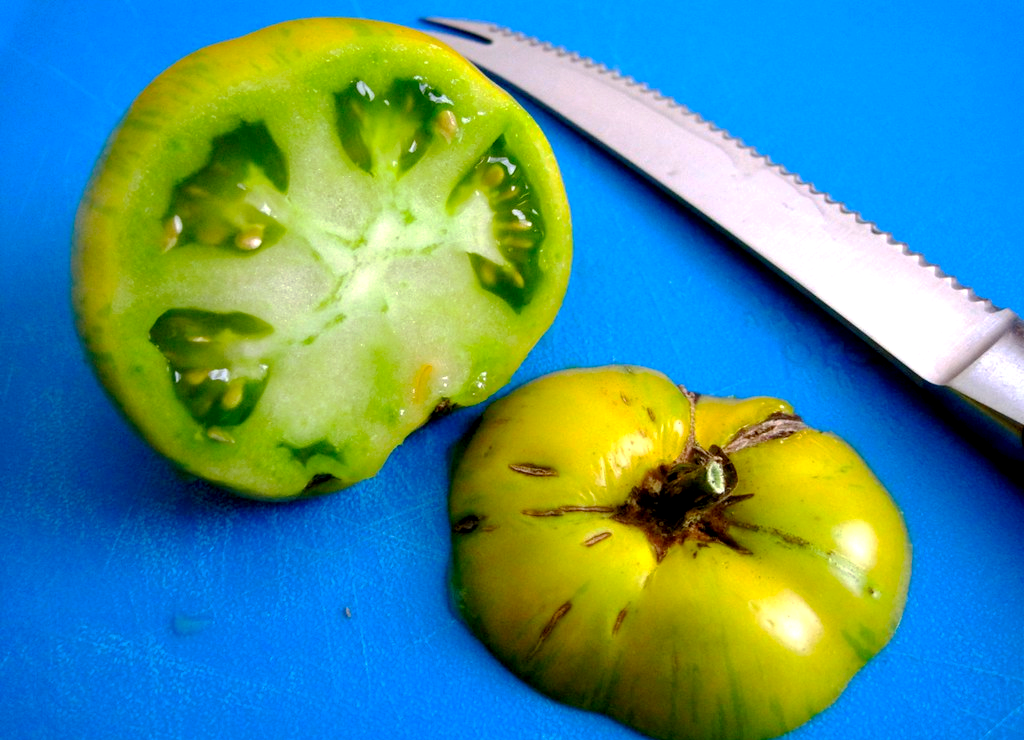Tomatoes are a bit of an ontological mess.
Botanically speaking, a tomato is a berry of the plant Solanum lycopersicum. This means it is a fruit, much like other berries such as blueberries, strawberries, and (my personal favorite) blackberries.
The fruit itself is much like other fruits, in that it contains the ovary and seeds of the plant. Unlike other fruits, it has much lower sugar content. Tomatoes are also 95% water. From a zoomed out view, eating a tomato is functionally the same as drinking a glass of water.
While tomatoes are nutritionally limited, they are considered fit for human consumption. The tomato plant is a member of the nightshade family. This means that it is also poison.
Fortunately, the toxin Tomatine is not present in the ripened berry. Somewhat less fortunately, we like to eat unripened tomatoes. This is in keeping with human beings’ penchant for enthusiastically consuming plant poisons.
Fried green tomatoes became culinarily trendy in the early 90s, but have existed as a recipe for awhile. While the effects of Tomatine on humans has not been extensively researched, we are able to consume modest amounts of unripened tomatoes without ill effects.
Tomatoes originated in the South and Central Americas, and were cultivated by the indigenous peoples of Mexico. Spanish conquest introduced the tomato to Europe, and it has since become a worldwide food staple. The tomato as we know it is a fruit born of pain.
Because of the globalization of the tomato, cultures and cuisines other than South American ones now have strong associations with the fruit, notably Italian cooking. This is an example of forced trans-cultural diffusion.
With this diffusion comes another critical aspect of tomato-ness: monoculture. For many of us, the platonic concept of a tomato is a red, fist-sized orb. This is largely due to market forces. However, tomatoes have a staggering amount of biological diversity. The next time you get a chance, see if you can get your hands on a green zebra.

“Fresh Local: Green Zebra Tomatoes: Cut hero” by bhamsandwich is licensed under CC BY-ND 2.0.
Tomatoes also have a legal aspect to consider. In Nix v. Hedden the United States Supreme Court ruled that the tomato should be classified as a vegetable. Ignoring the technical botanical classification, the Court ruled tomatoes qualified as a vegetable by classification of application. We won’t even get into how Nix v. Hedden led to the ketchup-as-a-vegetable controversy, but I assure you it is a Whole Thing.
So, to recap. Tomatoes are:
- a berry produced by a plant,
- more water than anything else,
- eaten when both nonpoisonous and poisonous,
- associated with cultures other than the one that initially cultivated it,
- commonly thought of as a single thing due to economics, despite being incredibly diverse,
- legally compelled to be considered a vegetable.
So, where do you put a tomato?
Tomatoes are physical objects. This means they can only be in one place at a time. This differs from digital objects, which may exist in multiple areas depending on how their metadata is utilized.
For this sort of situation, an object’s placement is typically informed by its supercategory status. This means the taxonomy we impose on objects directly affect the context of how we encounter them. While it seems logical in the general sense, things start to break down the closer you look.
You might find a tomato in a hardware store, but you won’t find it with other pesticides. Tomatoes in this context typically aren’t sold as a foodstuff, either. They’re presented in more of an agricultural context. You might also find some loose tomatoes at a bodega, but that’s not where our collective understanding of “tomato location” is.
For most of us, tomatoes are food, meaning you expect them to be in grocery stores. But this is also tricky.
Even though they are mostly water, you won’t find tomatoes in the beverage isle. You might, however, find some tomato juice there. Curiously, tomato soup will not be present. You also won’t find tomato soup with pasta sauce, which is segregation via viscosity raising its rare and ugly head. Food items in grocery stores are cunningly arranged by type rather than variant, so I’ll begrudgingly grant them this.
Vexingly, you also won’t find tomatoes in the fruit section of the grocery store. It turns out “tomato location” is a bit of a self-reinforcing problem: people expect tomatoes to be located where they expect tomatoes to be located. A rogue, first-order logician grocer pursing their idea of categorical purity in store layout stands to lose customers—and therefore profit—if they deviate from our preexisting expectations.
This is all to say that:
- Tomatoes are full of contradictions,
- Classifying things may seem like a neutral, academic exercise, but it is oftentimes not,
- Information is affected by multiple factors, including cultural, economic, and political forces,
- External conditions influence internal classification,
- Tomato soup is technically fruit soup and that’s kind of messed up,
- Information architecture is hard.
